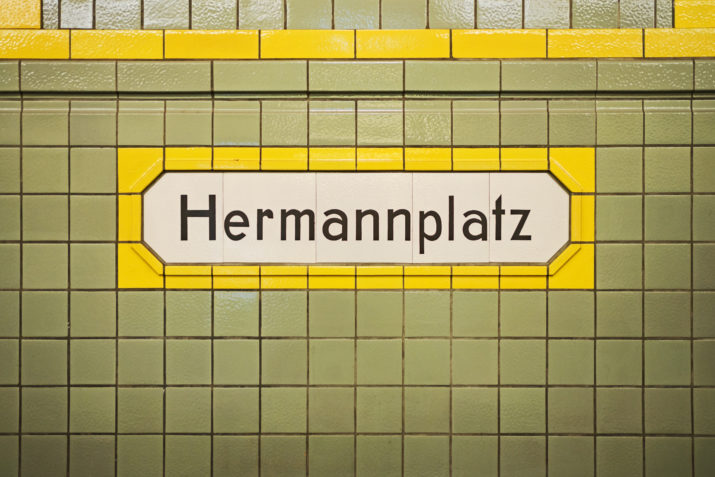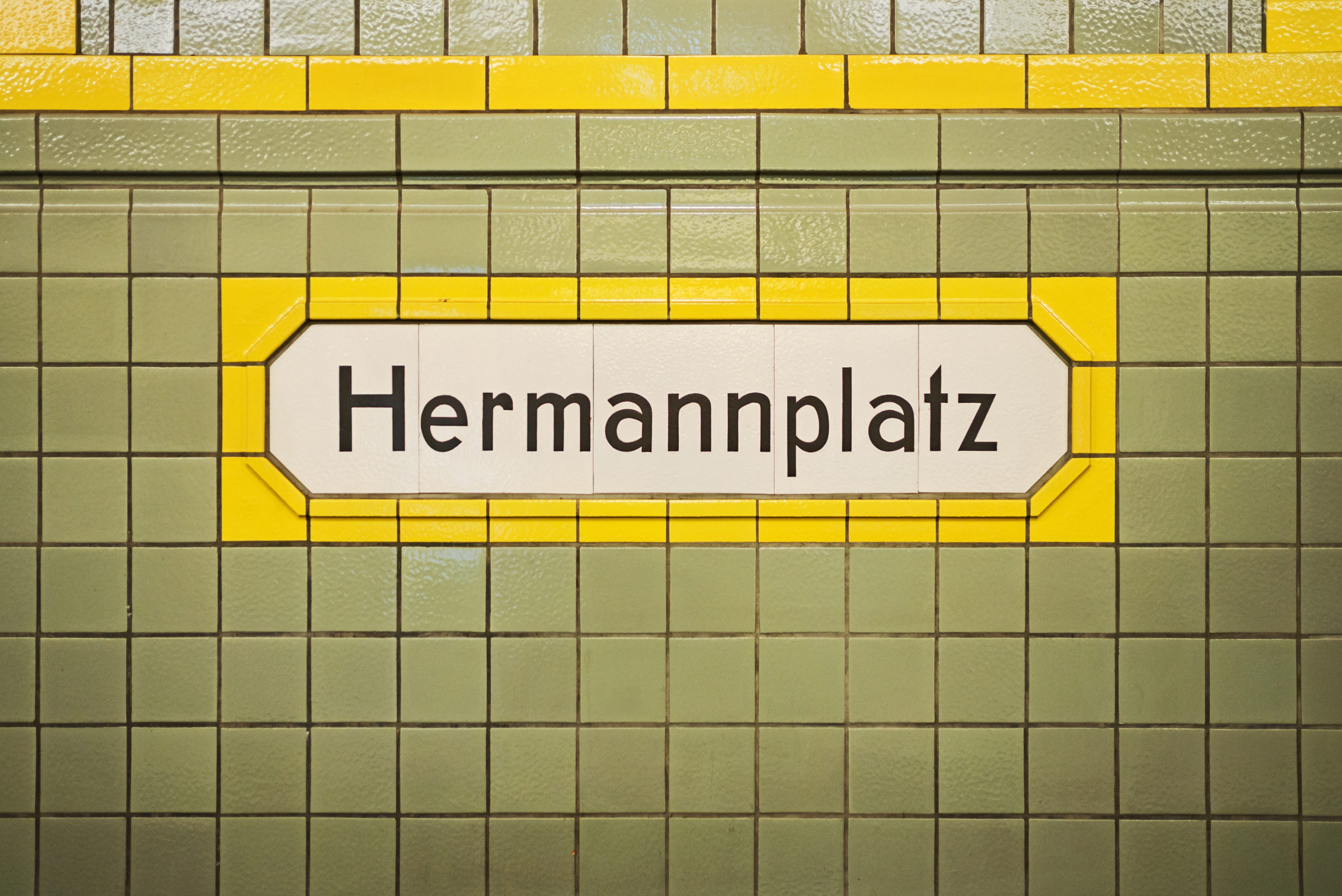

Even in these pandemic-ridden winter months, Hermannplatz, in Berlin’s North Neukölln, is bustling with activity. I emerge from the underground among market stalls and food vendors, walk past the old mall that is soon to be replaced by a more ambitious complex, and get to the crossing lights. There, I notice a new, tall white building on the other side of the road: a brand new apartment complex that will not be of much help to low income Neukölln residents who are failing at the fringes of an increasingly competitive rental market. I am here because I have a meeting at a nearby cultural organization to discuss working together on a project that uses ethnographic and artistic methodologies to create an informal map of the neighborhood. It consists of taking walks with a group of residents (among them refugees), record participants’ impressions, and share the results with the rest of the neighborhood’s residents in an open-source database.
The first meeting with a representative of the organization is quite satisfactory, especially since we seem to agree that we both want to focus on the process rather than the outcome. The process consists of the actual walking and the recording of the walk by the participants, who are encouraged to choose a format they are comfortable with (photos, texts, sounds, etc.) without any pressure to produce a polished final outcome. The second meeting, however, goes down very differently. I grow increasingly uncomfortable, as it’s clear that the people I’m talking to aren’t familiar or aren’t comfortable with the kind of project I am proposing and would like to radically transform it, with a lot of focus on “artistic quality” and documenting the walks as if they were performances, sidelining somehow the collaborative and informal aspect to aim for a polished final “product.” A couple of weeks after the meeting one of the intended participants mentions having worked with the same organization in the past and alludes to “chaotic” management and struggles to produce revenue, which in turn led to the involvement of a city office to manage those “inefficiency” issues. I decide to take a step back. While this failed collaboration might be seen as an example of micro-scale conflict at the grassroots level, and thus attributed to interpersonal issues, or problems internal to the organization, a much more productive approach is to instead consider it within the larger context. In this case the context is that of gentrification at the neighborhood level and art-based interventions. Reflecting on these issues can in turn lead to a more thorough understanding of grassroots level dynamics and initiatives.
Gentrification in Berlin
Gentrification is described by Hyun Bang Shin as “the commodification of space accompanying land use… changes in such a way that it produces indirect/direct/symbolic displacement of existing users and owners by more affluent groups…”1 The term was coined by Ruth Glass who referred to it about 1960s London, but the phenomenon it describes has since expanded globally, simultaneously maintaining its core features and manifesting itself locally in specific ways. The term itself remains contested among specialists,2 for example for being too specific to urban contexts in the Global North, but it remains useful as a synthetic way to describe a well-recognizable tendency in the production of urban space. 3 In a gentrified urban context what is bought and sold is not solely land or buildings, or any other concrete feature of urban space, but their potential to attract further investments (further buy-and-sell). In a global economy that has become increasingly financialized, this potential grows increasingly abstract from parameters that are related to urban dwellers’ everyday experience and place-making processes. Urban design in development areas tends to turn away from a haptic appreciation of space4 and treat city dwellers like city users. The users of urban space are enticed to be around long enough to consume it but not to dwell there. Not only do they not fully inhabit urban space, but they are not encouraged to produce meanings for themselves, especially if those meanings could contradict those anticipated by planners.5 There is also a tendency for urban governance to increasingly seek a highly sanitized and tightly controlled space, as public space is increasingly (and often secretly) privately owned.6
This disempowerment of the urban grassroots is a central feature of neoliberal urban governance. While it is true that “gentrification [entails] power struggles between haves and have-nots,”7 it has to be clear that it is not a matter of competition between individuals. The real players are those capable of initiating “broader political economic processes that result in the unequal and uneven production of urban(izing) space.”8 These players are among the ranks of global private investors and the various levels of the state. As the success of neoliberalism in dictating the global economic agenda has meant a receding welfare state even in Western Europe, public and private urbanizing strategies have become more closely intertwined than one would expect, as has been quite evident in Berlin in the past three decades.
German reunification saw the emergence of a desire among the local and national elites to reaffirm Berlin as both a global metropolis and Europe’s richest country’s capital. This was accompanied by a certain hostility towards the “provincialism” and “backwardness” of socialist society, which prompted a call to West Berliners (and Germans) to regain ownership of the city, and especially the city center.9 The political milieu, along with elite architects and planners seemed to operate with a clique mentality.10 These hegemonic players overwhelmingly re-imagined the city around “order, Prussian aesthetics, sparse coloration, use of stone, a tendency towards straight rather than curvy compositions,”11qualities that were intended both literally and metaphorically. Discourses of modernization, beautification, free house-market, and reconnecting with the city’s history fit well with these expectations while providing a justification for an aggressive privatization of the built environment that was also applied as a solution to the dire financial situation (made worse by the banking crisis of the early 2000s).12 At the same time, both politicians and an ever growing number of grassroots movements established new staples of Berlin’s urban culture based on maintaining socioeconomic diversity in the inner city and promoting grassroots participation and accountability in local government.13 German political discourse has stood by these principles to this day, even when the reality on the ground, including policies and contracts with private investors, has often appeared to contradict them.
Having emerged in the inner city in the early 2000s, gentrification reached Neukölln at the end of the decade.14 While gentrification in Berlin has to be read city-wide to appreciate its growth and foresee future developments, each district is culturally, historically, politically, and bureaucratically different.15 Some of Neukölln’s peculiarities lie in its relative laxity of regulations around housing and building; a long-held reputation for being dangerous; stages of gentrification coinciding with the boom of international attention towards the city in the early 2010s; and the presence of one of the world’s largest inner-city parks (Tempelhofer Feld). In recent years, the district also seems to have become a target for white-extremist violence, something that has been cause of growing concern among local activists and which adds to the tensions around the right to urban space.16
Aesthetic economy and the city
In Berlin like in other cities, to counterbalance the effects of gentrification, or to revitalize “fragile” neighborhoods, city administrations often promote culture-led transformations, branded as community-level interventions.17 Whether the revitalization implements already existing artistic initiatives or generates a plan from scratch, the focus is always on the creative, participatory, empowering, and bottom-up nature of such endeavors.18 Communities willingly take part in the hope of solving real, pressing, issues, while artists are driven to places of urban change because of the creative and productive potential they harbor.19 However neither art nor public intervention can play a neutral role, as they too inevitably participate of the prevalent neoliberal socioeconomic and political framework.20 Art is highly valued in the post-industrial city both by administrations and investors because of its innate ability to manage and codify space,21 and to produce value through aesthetic labor. Aesthetics is to be intended here in substantial terms as the aspect of reality that is connected with intangible qualities that evoke emotions and feelings.22 The intangible quality of space is what Gernot Böhme calls “atmosphere.”23 Aesthetic economy then describes a late-capitalistic phenomenon that centers on the satisfaction of desires to keep the cycle of production in perpetual motion, given that satisfaction actually reproduces desires instead of quenching them. Aesthetic labor is all that increases desire, which is often attained by a staging―a representation (Inszenierung)―of reality. 24 The advantage of using the aesthetic economy framework is that it acknowledges the importance of aesthetics and imagineering―instead of trivializing them―while offering the tools to foreground the related socioeconomic dynamics at various scales.
Art-based community initiatives that intervene in such a layered context cannot be assumed to be positive, or even just neutral, or in any case detached from their socioeconomic dynamics. By inevitably playing into the aesthetic economy framework, initiatives might disguise or even contribute to the perpetuation of inequalities, the exploitation of citizens’ agency, and the appropriation of their artistic creations, all factors that tend to pave the way to full-scale gentrification.25This is especially insidious when focusing on the community aspect. Aesthetic labor in the urban context in fact is not solely a matter of extracting value from explicitly aesthetic interventions, but can result from the individuation and objectification of the atmospheres that unfold from a certain way of life in a certain place. The additional value might for example come from the desirability of a non-conformist way of life, as with Neukölln being seen as gritty, multicultural, working class by those who perceive themselves as (white) middle-class and well-integrated in mainstream society.26 The comparison is, of course, patronizing as it comes from a position of privilege that can ignore the less pleasant aspects of that same way of life (i.e. poverty, discrimination, marginalization) and those that do not fit in a certain system of desires. In a way, aesthetic labor extracts the desirable aspects and leaves behind the non-marketable ones. What remains is a representation that is curated for maximum impact, but might at the same time leave behind important meanings, so that the result is quite “flat.” This flatness can also be found in certain architectural designs that privilege the visual, giving the impression that urban space is there to be looked at, to be perceived at a distance, without engaging with it in a more direct way.27. Such design choices play well into an urban governance that seeks to control and regiment city life by offering a pleasing visual experience, while at the same time limiting the more “hands-on” dimension of living the city, the actual dwelling in its most complete sense.28
Art-based ethnographic approach to urban gentrification
The “stageification”29 that fragments the everyday and turns it into a spectacle is not an exclusive feature of the post-industrial real estate market and the aesthetic economy. It might very well make its way into social research, especially when it relies on ethnographic approaches and other methodologies that engage with the quotidian, intimate sphere, and focuses on marginalized and fragile groups and situations. Often beyond the intentions of early ethnographers, ethnographic research nonetheless participated in the colonial enterprise, serving the purpose to “extract” materials, including (inevitably fragmented) records of “exotic” extra-ordinary lives, which were in turn used to devise methods of governance and control or to be exhibited themselves.30 To this day, some dynamics that emerge at the intersection between research, art, and engagement might unwittingly reproduce forms of objectification and stageification of the lives of the individuals and communities involved. This in turn might end up indulging the same forces that the research intended to problematize, change, dismantle, or avoid. To reduce this risk one might start by embracing conflicts, ambiguities, and contradictions that emerge during research, without treating them as exceptions but instead as integral aspects of the urban experience. One of the most oppressive aspects of gentrified space is in fact the fictitious homogeneity and artificial suppression of conflict. Space, however, is produced through a constant negotiation among different actors, and as such it is a dis-orderly, open-ended process that always maintains a degree of unpredictability. And this is even more true of cities, where the density of interactions inevitably amplifies such dynamics.31 What can be most beneficial is then for the researcher to engage with the power imbalances, shortcomings, and discrepancies that unfold at various levels, with a self-reflexive approach to both ethnographic and artistic tools.32
Francesca Pegorer is a PhD Candidate in Socio-Cultural Anthropology at the University of British Columbia (Vancouver).
References:
1 Hyun Bang Shin, Lees, L. and López-Morales, E., “Introduction: Locating gentrification in the global East” in Urban Studies, 53(3), 455–470
2 See for example: Charlotte Lemanski, “Hybrid Gentrification in South Africa: Theorising across Southern and Northern Cities.” Urban Studies 51, no. 14 (November 2014): 2943–60; D Asher Ghertner. “Why gentrification theory fails in ‘much of the world’”, City, 19 no.4 (2015): 552-563; Michael Gentile, “Gentrifications in the Planetary Elsewhere: tele-urbanization, Schengtrification, colour-splashing, and the mirage of “more-than-adequate” critical theory” Urban Geography, 39 no.10 (2018): 1455-1464.
3 Loretta Lees with Phillips, M. (eds.), Handbook of Gentrification Studies, (Cheltenham: Edward Elgar Publishing 2018), 1-10; Setha Low, Spatializing Culture: The Ethnography of Space and Place (New York: Routledge 2016); also see Elvin Wyly, “Gentrification on the Planetary Urban Frontier: The Evolution of Turner’s Noösphere.” Urban Studies 52, no. 14 (November 2015): 2515–50
4 Juhani Pallasmaa, The eyes of the skin: architecture and the senses, (Chichester: Wiley-Academy, 2005)
5 Ghent Urban Studies Team, The Urban Condition: Space, Community, and Self in the Contemporary Metropolis, (Rotterdam: 010 Publishers 1999); see Henri Lefebvre, The Production of Space, (Oxford: Blackwell Publishing 1991)
6 Stephen Graham, Cities under Siege: The New Military Urbanism, (London: Verso 2011)
7 Hyun Bang Shin, Lees, L. and López-Morales, E., “Beyond Anglo-American gentrification theory” in Loretta Lees with Phillips, M. (eds.), Handbook of Gentrification Studies, (Cheltenham: Edward Elgar Publishing 2018): 13
8 Ibid.
9 Matthias Bernt et al., The Berlin Reader. A Compendium on Urban Change and Activism, (Bielefeld: Transcript-Verlag, 2014)
10 Ibid.
11 Ibid.
12 Ibid.
13 Ibid.
14 Ibid.
15 Thomas Dörfler, Gentrification in Prenzlauer Berg?: Milieuwandel Eines Berliner Sozialraums Seit 1989, (Bielefeld: Transcript, 2010)
16 Sebastian Leber, “Die Nazis von Neukölln,” Der Tagesspiegel, March 8 2017, accessed March 1 2021,https://www.tagesspiegel.de/gesellschaft/neue-welle-rechter-gewalt-die-nazis-von-neukoelln/19470362.html; Andreas Kopietz, “Berlins Polizei rätselt über die rechten Anschläge in Neukölln,” Berliner Zeitung, November 25 2019, accessed March 1 2021, https://www.berliner-zeitung.de/mensch-metropole/berlins-polizei-raetselt-ueber-die-rechten-anschlaege-in-neukoelln-li.2039
17 Xabier Gainza, “Culture-led neighborhood transformations beyond the revitalization/gentrification dichotomy” in Urban Studies 54 (4), (2017) 953–970
18 Vanessa Mathews, “Incoherence and Tension in Culture-Led Redevelopment” in International Journal of Urban and Regional Research 38 (3), (2014) 1019–1036
19 Beth A. Uzwiak, “Community Engagement in Precarious Times: When Ethnography Meets Socially Engaged Art” in Anthropology Now, 8:2 (2016)
20 Ghent Urban Studies Team, The Urban Condition: Space, Community, and Self in the Contemporary Metropolis, (Rotterdam: 010 Publishers 1999)
21 Gernot Böhme, The aesthetics of atmospheres, (New York: Routledge, 2016)
22 Ibid.
23 Ibid.
24 Ibid.
25 Setha M. Low (ed.), Theorizing the City, (Piscataway, NJ: Rutgers University Press 1999); also see Vanessa Mathews, “Incoherence and Tension in Culture-Led Redevelopment” in International Journal of Urban and Regional Research 38 no. 3, (2014): 1019–1036; Stephen Pritchard, “Anti-Gentrification & the Intangible Rise of the Social Capital Artist”, colouringinculture.org (blog), June 17, 2017 http://colouringinculture.org/blog/artwashingsocialcapitalantigentrification
26 Matthias Bernt et al., The Berlin Reader. A Compendium on Urban Change and Activism, (Bielefeld: transcript-Verlag, 2014)
27 Juhani Pallasmaa, The eyes of the skin: architecture and the senses, (Chichester: Wiley-Academy, 2005)
28 Ghent Urban Studies Team, The Urban Condition: Space, Community, and Self in the Contemporary Metropolis, (Rotterdam: 010 Publishers 1999);
29 Barbara Kirshenblatt-Gimblett, Destination Culture: Tourism, Museums, and Heritage, University of California Press (1998)
30 Ibid.
31 Laura Nagler, Gentrification and Resistance, (Berlin: LIT Verlag, 2012); also see Sophie Wolfrum and N. Frohr v. Brandis, Performative Urbanism – Generating and Designing Urban Space, (Berlin: jovis, 2014); Doreen Massey, Space, Place, and Gender, (Minneapolis: University of Minnesota Press, 1994)
32 Beth A. Uzwiak, “Community Engagement in Precarious Times: When Ethnography Meets Socially Engaged Art” in Anthropology Now, 8:2 (2016)
Photo: Detail of the interior in Hermannplatz subway station in Berlin, Germany | Shutterstock
Published on April 1, 2021




